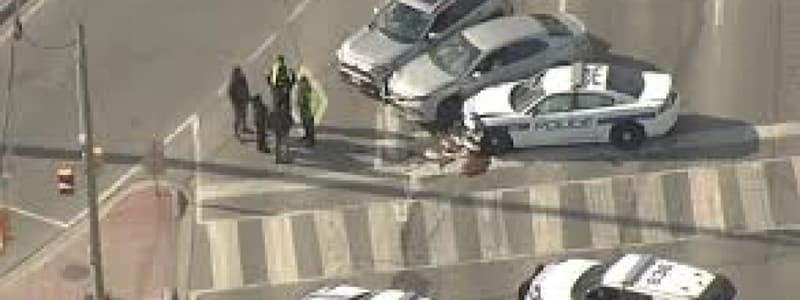Podcast
Questions and Answers
According to procedure, what potential consequences might a member face if they are at fault in a service vehicle collision (SVC)?
According to procedure, what potential consequences might a member face if they are at fault in a service vehicle collision (SVC)?
- Criminal or provincial charges, disciplinary action, driving assessments, or revocation of their Blue Card. (correct)
- Immediate suspension without pay pending investigation.
- A formal reprimand placed in their personnel file and a temporary loss of seniority.
- Mandatory reassignment to administrative duties.
Under what conditions should a Service Vehicle Collision (SVC) be recorded on a SRLD401 form?
Under what conditions should a Service Vehicle Collision (SVC) be recorded on a SRLD401 form?
- For all SVCs, regardless of the extent of damage or injuries.
- Only when the SVC involves an unmarked police vehicle.
- Only when the SVC results in personal injury to the member involved.
- When the SVC is deemed reportable under HTA criteria, including collisions resulting from intentional contact. (correct)
In the event of a Service Vehicle Collision (SVC), what is the primary responsibility of a supervisory officer and a TSV officer?
In the event of a Service Vehicle Collision (SVC), what is the primary responsibility of a supervisory officer and a TSV officer?
- To attend the scene and assume responsibility for all SVC investigations. (correct)
- To secure the scene and direct traffic flow around the collision site.
- To provide immediate medical assistance to the involved parties.
- To immediately notify the Chief of Police and await further instructions.
According to protocol if a Toronto Police Service member is involved in a Service Vehicle Collision within the City of Toronto, what immediate actions must that member take?
According to protocol if a Toronto Police Service member is involved in a Service Vehicle Collision within the City of Toronto, what immediate actions must that member take?
What action should a member take before ending their shift after being involved in a Service Vehicle Collision (SVC)?
What action should a member take before ending their shift after being involved in a Service Vehicle Collision (SVC)?
Following a Service Vehicle Collision (SVC) outside of Toronto, what steps should a member take regarding notifications?
Following a Service Vehicle Collision (SVC) outside of Toronto, what steps should a member take regarding notifications?
When investigating a reportable SVC, what specific piece of information regarding the involved member must the Traffic Services Officer include on the SRLD401?
When investigating a reportable SVC, what specific piece of information regarding the involved member must the Traffic Services Officer include on the SRLD401?
What is the key difference in procedure when a Traffic Services Officer investigates a non-reportable SVC compared to a reportable one?
What is the key difference in procedure when a Traffic Services Officer investigates a non-reportable SVC compared to a reportable one?
When investigating an SVC involving an unmarked Service vehicle and a member with covert identification, what additional consideration should be taken?
When investigating an SVC involving an unmarked Service vehicle and a member with covert identification, what additional consideration should be taken?
What is the first action a Supervisory Officer should take when notified about a reportable or non-reportable SVC occurring in the City of Toronto?
What is the first action a Supervisory Officer should take when notified about a reportable or non-reportable SVC occurring in the City of Toronto?
During a Supervisory Officer's investigation of a Service Vehicle Collision (SVC), if the involved Service vehicle is equipped with an in-car camera system (ICCS), what specific action must the officer take?
During a Supervisory Officer's investigation of a Service Vehicle Collision (SVC), if the involved Service vehicle is equipped with an in-car camera system (ICCS), what specific action must the officer take?
In the context of a Service Vehicle Collision (SVC), what does a Supervisory Officer's internal investigation aim to determine?
In the context of a Service Vehicle Collision (SVC), what does a Supervisory Officer's internal investigation aim to determine?
Following a Service Vehicle Collision (SVC), what specific document must a Supervisory Officer complete for each Service vehicle involved?
Following a Service Vehicle Collision (SVC), what specific document must a Supervisory Officer complete for each Service vehicle involved?
What action does the Unit Commander - Fleet & Materials Management (FLT) take upon receiving a copy of the SRLD401 or eReport after a Service Vehicle Collision (SVC)?
What action does the Unit Commander - Fleet & Materials Management (FLT) take upon receiving a copy of the SRLD401 or eReport after a Service Vehicle Collision (SVC)?
What is the primary responsibility of an Officer in Charge (OIC) when in receipt of a Service Vehicle Collision Report (SVCR)?
What is the primary responsibility of an Officer in Charge (OIC) when in receipt of a Service Vehicle Collision Report (SVCR)?
If criminal or provincial charges are warranted against a member involved in a Service Vehicle Collision (SVC), and immediate action is required, what is the appropriate procedure?
If criminal or provincial charges are warranted against a member involved in a Service Vehicle Collision (SVC), and immediate action is required, what is the appropriate procedure?
According to the document, what is the responsibility of an officer upon receipt of a Provincial Offences - Notice of Trial related to a Service Vehicle Collision (SVC)?
According to the document, what is the responsibility of an officer upon receipt of a Provincial Offences - Notice of Trial related to a Service Vehicle Collision (SVC)?
When notified of a Service Vehicle Collision that has occurred outside of the City of Toronto, what is the responsibility of the Officer in Charge - Toronto Police Operations Centre?
When notified of a Service Vehicle Collision that has occurred outside of the City of Toronto, what is the responsibility of the Officer in Charge - Toronto Police Operations Centre?
What does 'Intentional Contact' refer to in the context of Toronto Police Service vehicle operation?
What does 'Intentional Contact' refer to in the context of Toronto Police Service vehicle operation?
What is the monetary damage threshold at which a collision must be reported, according to the definition of a 'Reportable Collision'?
What is the monetary damage threshold at which a collision must be reported, according to the definition of a 'Reportable Collision'?
Flashcards
Service Vehicle Collision (SVC)
Service Vehicle Collision (SVC)
Collision involving a Toronto Police Service vehicle where involvement is direct or indirect.
Consequences of SVC Fault
Consequences of SVC Fault
If at fault in a service vehicle collision (SVC), a member may face charges, disciplinary action, training, or revocation of their Blue Card.
SVC Investigation Responsibility
SVC Investigation Responsibility
Supervisory and TSV officers investigate SVCs. A Marine officer handles investigations involving vessels from Specialized Emergency Response - Marine (Marine).
Reporting a Reportable SVC
Reporting a Reportable SVC
Signup and view all the flashcards
SVC Procedures in Toronto
SVC Procedures in Toronto
Signup and view all the flashcards
Service Vehicle Collision Reduction Committee (SVCRC)
Service Vehicle Collision Reduction Committee (SVCRC)
Signup and view all the flashcards
SRLD401 Submission Deadline
SRLD401 Submission Deadline
Signup and view all the flashcards
Study Notes
- When a member is at fault in a Service Vehicle Collision (SVC), they may face criminal/provincial charges, disciplinary action, driving assessments/driver development training, and/or revocation of their Blue Card
Reporting SVCs
- Reportable collisions under HTA criteria, including those with intentional contact, must be recorded on SRLD401 and submitted electronically to the MTO
- Non-reportable collisions under HTA criteria should be recorded on an eReport
Responsibility for Investigation
- A supervisory officer and a TSV officer are responsible for SVC investigations, with the supervisory officer ideally from TSV
- If a Specialized Emergency Response - Marine (Marine) vessel is involved, a Marine officer conducts the investigation
Member Responsibilities
- Members operating a Service vehicle must meet the driving standards set by the HTA and Toronto Police College
- If a Service vehicle is damaged other than by a motor vehicle collision, members must comply with Procedures
- If involved in an SVC in Toronto, members must:
- Remain at the scene
- Determine if medical assistance is needed
- Notify the communications operator and a supervisor
- Record details in the memorandum book or on a TPS 649
- Comply with Procedure 07-01
- Request police agency to attend and investigate
- Report necessary information to the investigating officer per "Duty to Report an Accident" Sec 199 of the HTA
- Members needing medical treatment must remain at the scene and speak with the investigating officer, or they may face PSA and/or other charges and increased penalties
- Before going off duty, members must:
- Scan a copy of their memorandum book into the eReport
- Record the damage on the Vehicle Damage Report in the unit file
- If involved in an SVC outside of Toronto, members must:
- Remain at the scene
- Determine if medical assistance is needed
- Notify the communications operator and a supervisor
- Record details of the circumstances
Traffic Services Officer Responsibilities when investigating a reportable SVC
- Conduct the investigation
- Consult with the attending supervisory officer
- Complete the officer information on the SRLD401 with the member's address (40 College Street, Toronto Ontario M5G 2J3), phone number (416-808-2222) and the vehicle registration/insurance information
- Complete the SRLD401 using Versadex's eMVA xForm and Quickscene diagramming applications
- Complete the eReport with scanned notes and submit to the supervisory officer before reporting off duty, unless authorized by the OIC
- For non-reportable SVCs, comply with item 6, but an SRLD401 is not required
- Complete field notes with diagram or memorandum book notes, complete an eReport, and include the incident's date, time, location, brief synopsis, damage description, and estimated value, and scan all notes into eReport
- When investigating an SVC with an unmarked Service vehicle and covert identification, record the specifics as described on the documents
- Consult with a supervisory officer before reporting if the collision location is at or near a covert police facility
Supervisory Officer Responsibilities
- When notified of an SVC in Toronto, promptly attend the scene, provide assistance, and conduct an internal investigation
- Notify the respective OIC
- Ensure witness statements and evidence are gathered before reporting off duty
- If the Service vehicle has an ICCS video, review the video
- Comply with Procedures if the SIU mandate may be invoked
- Request a copy of the ICCS video from PVEMU by e-mail with date, time and fleet number if it's required for court or training
- Conduct an internal investigation to determine if a criminal offense, provincial offense, conduct issue, or training requirement applies, or if no further action is needed
- Complete a TPS 559 for each Service vehicle and the Supervisor's Determination section
- Ensure the damage is recorded on the Vehicle Damage Report and send a copy of the SRLD401 or eReport to the Unit Commander - Fleet & Materials Management (FLT)
- Review the Service Vehicle Collision Report (SVCR) for completeness, accuracy and investigative integrity, then submit to the OIC before reporting off duty
- When attending an SVC outside Toronto, promptly attend, notify the involved member's Officer in Charge, liaise with the investigating officer, obtain a copy of the collision report, complete a TPS 559, ensure the damage is recorded, and send a copy of the SRLD401 or eReport to the Unit Commander - FLT
Criminal or Provincial Charges
- Consult with the Unit Commander before laying a charge, if immediate action isn't required
- If immediate action is required, take action, then advise the Unit Commander as soon as practicable
- Initiate the applicable charge and comply with the applicable procedures for a conduct issue
- Upon receipt of a Provincial Offences - Notice of Trial, assume the role of case manager
- Consider all other factors in a collision and identify appropriate measures like training or equipment placement
Officer in Charge (OIC) Responsibilities
- When notified of an SVC within or outside divisional boundaries, or when detailed by the TPOC, ensure a supervisory officer is assigned to attend and conduct an internal investigation, if applicable
- Notify the OIC - TPOC when an SVC occurs outside of Toronto
- When in receipt of a SVCR, review for completeness, accuracy, and systemic integrity and ensure the collision is investigated per Procedures
- If the unit vehicle has ICCS, ensure the ICCS video is reviewed, and comply with procedures if the SIU mandate has been or may be invoked
- If concurring with the report, submit the original to TSV Unit Commander (Designate) - SVC Review
- The service must forward all SLRD401s to the MTO within 10 days of the vehicle collision
Officer in Charge - Toronto Police Operations Centre
- When notified of an SVC outside Toronto, notify the Duty Senior Officer - TPOC (Duty Senior Officer)
- Upon notification by the Duty Senior Officer that a supervisory officer is required at an incident outside Toronto shall request a supervisory officer from the involved member's unit or the division nearest to the SVC
- Notify the applicable police service that a Toronto Police Service supervisory officer is attending or not attending
Duty Senior Officer - Toronto Police Operations Centre
- When notified of an SVC outside Toronto, determine whether a supervisory officer should attend the scene and notify the OIC - TPOC of the determination
Definitions
- Intentional Contact is when a Toronto Police Service vehicle intentionally comes into contact with another vehicle, person, or object to stop a threat
- Marked Vehicle is a Service vehicle used primarily by uniformed officers with Toronto Police Service markings, emergency lighting, and a forward-facing electronic siren, meeting HTA and Policing Standards Manual requirements
- Reportable Collision involves personal injury, death, or property damage exceeding $2000, requiring reporting per the Highway Traffic Act
- Service Vehicle is any vehicle, vessel, aircraft, or bicycle owned or operated by the Service for duties
- Service Vehicle Collision (SVC) is a vehicle collision involving a Toronto Police Service vehicle where involvement is direct or indirect
- Service Vehicle Collision Reduction Committee (SVCRC) is a panel that consists to monitor Toronto Police Service vehicle collisions for trend analysis, problem identification, quality assurance and training issues, and report its findings to the Chief of Police
- Service Vehicle Collision Reduction Program (SVCR Program) is a program managed by Professional Standards which monitors Toronto Police Service vehicle collisions for trend analysis, problem identification, quality assurance and training issues
- Service Vehicle Collision Report (SVCR) consists of a SRLD401, traffic officer notes, witness statements (if applicable), involved member's notes, and a TPS 559
Studying That Suits You
Use AI to generate personalized quizzes and flashcards to suit your learning preferences.




